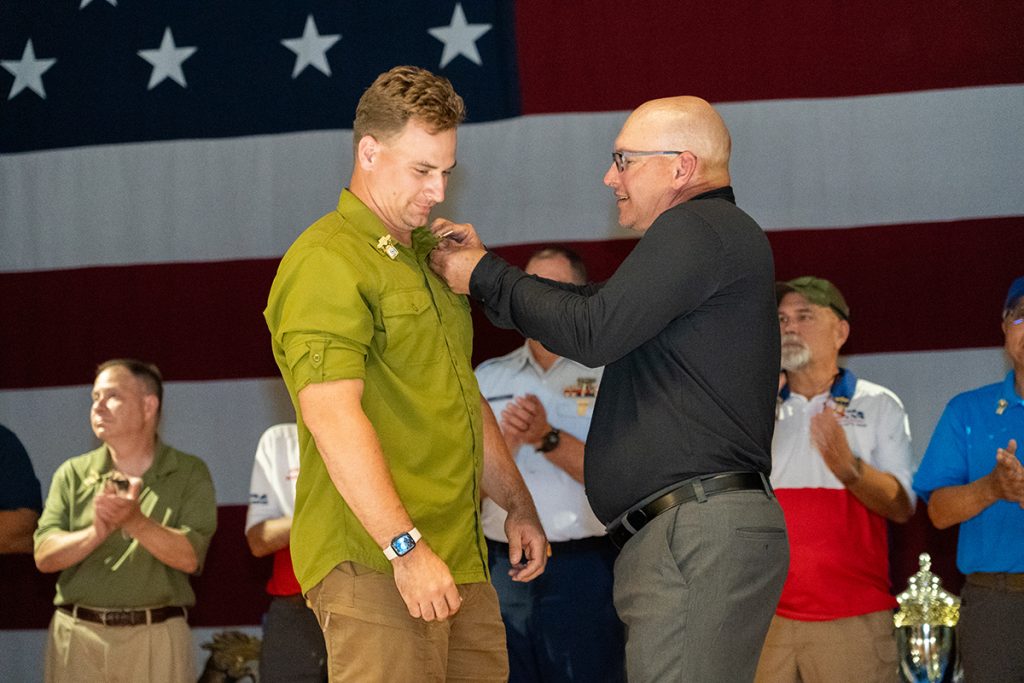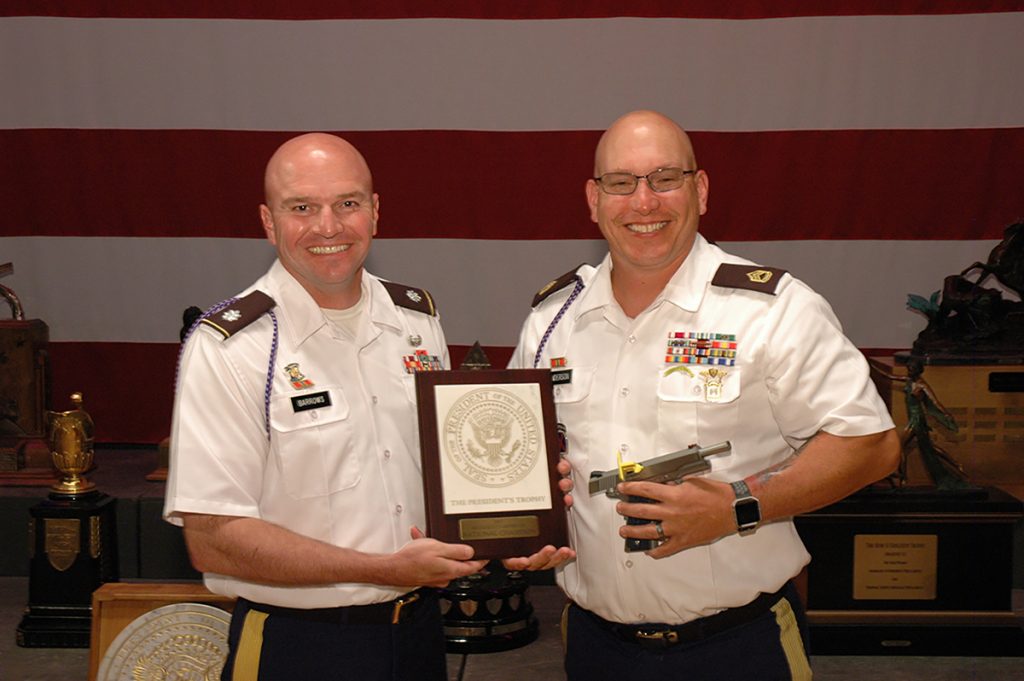How To Prepare for Pistol EIC Events
September 30, 2024
Civilian Marksmanship Program▸The First Shot▸How To Prepare for Pistol EIC EventsBy Jim Henderson, CMP Pistol Manager
Hello! To kick things off, this particular article will focus on Excellence-In-Competition (EIC) matches: how to go about them, general history and maybe a little personal history thrown in for good measure.
The Excellence-In-Competition matches started over 100 years ago. Since then, record keeping started out very sporadically but has improved over the decades. As far as we can tell, per the records we have, the first badge was awarded to 1LT H R Anderson, USA. It looks like the badge was earned in 1884, and there were a total of 23 badges earned that year.
Now, keep in mind that in some years there are people listed twice in the same year or consecutive years. Computers were a little sketchy back in the late 1800s. As it stands today, there have been 16,441 badges presented. Again, take that as you will, as some of the early record keeping was different than it is today.

As the CMP continues to increase its footprint in the shooting sports, more and more people are hearing about becoming a Distinguished shooter. There are several Distinguished Badges under the CMP umbrella. As we grow, more people are asking for a “how to” on the EIC matches. If you’re a seasoned competitor or a brand new shooter, you should be able to find something of interest in this article.
So, what does earning the badge look like?
The specific score percentages, minimum score and the minimum number of non-distinguished competitors to have a legal match can all be found in the current CMP Pistol Competition Rules, available on the CMP website at https://thecmp.org/competitions/cmp-competitions-rulebooks/. A straightforward way to explain the process is that you shoot the EIC matches to earn points towards the Distinguished Badge. There is a minimum score that must be met, even if you win the match, to earn points. You can shoot all the EIC matches you want in a year, but you can only earn points at five with the addition of one more opportunity at the National Matches. That makes a total of six per calendar year.
Over the years, the course of fire has changed, the requirements have changed and the allowed list of pistols has changed dramatically – especially in recent years as firearm and ammunition technologies have had an influx of many needed improvements.
I started in 1989 when they issued the ammunition on the line at Camp Perry during the National Matches. My thought process was to separate all the like headstamps together and shoot those as a group in slow fire. I felt like I had to really pay attention to that first shot at 50yds, it could be an eye opener!

These changes were driven by the firearm industry with a growing number of pistols and the lack of reloading components. You can find all this information in the CMP Pistol Competition Rules on the CMP website at https://thecmp.org/competitions/cmp-competitions-rulebooks/.
So, with that basic introduction, here we go on the details…
Course of Fire.
You can find the exact course of fire and range commands in that same rulebook mentioned above. The short of it is that it is a 30-shot match fired at 50yds and 25yds.
One string of 10 shots in 10 minutes, fired at 50yds on the NRA B-6 target. Go down and score, then move your target to the 25yd line.
Then, you will shoot two five-shot strings in 20 seconds at 25yds on the NRA B-8 target. Go down range and score.
Then, you will shoot two five-shot strings in 10 seconds on the NRA B-8 target. Go down and score.
Once the targets are scored, make sure you verify every shot value, not just the string total. It’s a good practice to do this after every string of fire, since you cannot go back and challenge a shot value after the target has been shot on for the next string.

Equipment.
Pistol shooting has its own specific rabbit holes on this topic, but what you truly NEED to get started is very simple. You need a pistol that meets the rules. Again, you can find those rules in the CMP Pistol Competition Rules on the CMP website at https://thecmp.org/competitions/cmp-competitions-rulebooks/. You’ll need ammunition and magazines as well.
If you’re going to shoot a revolver, make sure you have the proper set up for your ammunition. Moon clips or speed loaders, for example. After those things, the list is fairly easy and short: eye and ear protection, a screwdriver to adjust your sights, staple gun and staples, something to write on and with.
You can throw it all in a small backpack. There will be people that say you have to have a scope. A scope to view your impacts on the target is a nice thing to have but isn’t mandatory. A gun box of some kind is nice to have as well, but they can be expensive. If starting on a budget, make this a later purchase.
Speaking of a budget, I would suggest starting with a pistol that you currently own or have access to. This is another rabbit hole danger zone. You will hear all manners of advice on what you need and just “have to have.” You can spend thousands of dollars chasing equipment points. In my opinion, I suggest spending that time and energy on ammunition and training.
Preparation and Training.
Most bookstores have one if not more aisles dedicated to sports psychology and mental management. I mean, there are A LOT! Most are not, but some are specifically shooting related, and all information is useful information. Take everything, all advice and information, with a grain of salt. Not everything that worked for someone else will work for you. There is a great deal of advice available on the web as well. If someone shares an experience that has caused them pain, respond with “thank you” and then step away; shooting should not inflict harm.
I mention the mental management topic first, as this is the most important part of the shooting sports, in my opinion. The physical part of shooting has its issues, but if your mind isn’t on the same page, progress will be very difficult.

Before the competition, do what you normally do. If you drink coffee, drink it. If you feel that it makes you jittery before matches, it is probably more the additive of the competition elevating your anxiety and not the caffeine. Not having coffee has been proven to have a far larger negative effect on your body and mind. Shooting can be summed up simply as a love affair with monotony.
You should strive to do the same thing every single time you raise the pistol. Dry firing or live fire, doesn’t matter. Do it the same way every time. This will help build a shot process. This process is a living document either in your head or written down. If you are just starting out, I suggest writing it down for now. The only goal I believe in is to deliver my proven shot process to the best of my ability at any given moment. Period. No more, no less.
Once you’ve amassed all the things you need for the match, be early to the range. By that, I mean if the match starts at 8:00 a.m., be there no later than 7:15. This will give you enough time to pay your match fees, find your firing point and get your target placed if need be. This should give you a sense of calm. You are where you’re supposed to be, doing what you’re supposed to do.
Focusing on the task at hand without becoming hyper-focused is a huge benefit.
Join in on the conversion on the CMP Forum.
I hope this will at least start the conversation and become a great place to learn and discuss the most complicated easy thing I’ve ever done in my life! Join us on the CMP Forum for Pistol at https://forums.thecmp.org/forum/cmp-competitions/eic-pistol.
Jim:
Excellent article!
M.